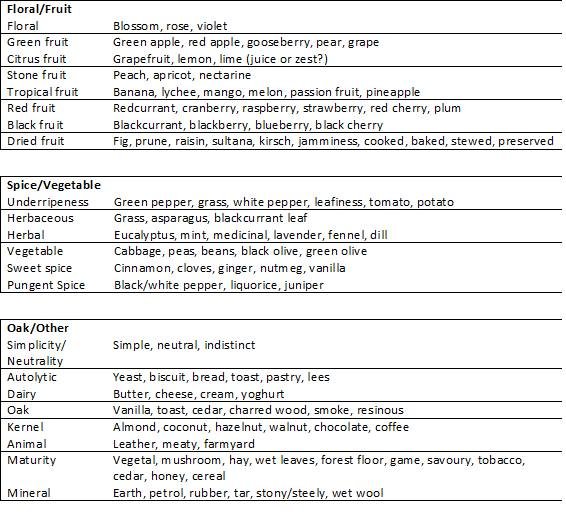The Cooking Sketchbook #2 | Tasting and Evaluating Wine
Hello everyone! For a few weeks this supposedly-all-about-cooking series will be mostly about wine tasting as I have decided to take on a new challenge – I’ll be taking the WSET Level 2 Award in Wines and Spirits! Wine & Spirit Education Trust is one of the globally recognised educator in wine, spirits and sake and I am hoping to use this as an opportunity to expand my knowledge in these alcoholic beverages. As a part of exam preparation, I would like to share some knowledge about wine and spirits with you all. Most materials will be adapted from the WSET textbook “Wines and Spirits: Looking behind the label” and conversations I had in class. I’m not intending to make this a self-containing reference book, so the contents will most likely be heavily condensed and may not cover everything in the curriculum. Please note that these contents are primarily used as a revision tool for myself. You will almost most likely find yourself needing to Google to gain a better understanding of some of the concepts – such as what means by appearance intensity. However, if you are interested about these beverages and are new to the field, you should still find this series interesting and it should provide you plenty of pointers to explore further.
Topic 1: Tasting and Evaluating Wine
1.1 Preparation
To perform wine tasting, the location should be free of odour. This means that there should not be smells of cleaning products, tobacco, food or perfume. To facilitate judging, the room should have good natural light and white surfaces. Chewing a piece of bread can help remove any lingering flavours.
1.2. The WSET systematic approach
Appearance → Nose → Palate → Conclusion
1.2.1. Appearance
Appearance is very useful to let us know if a bottle of wine is spoiled. Such wines usually look dull and will have a hint of brown (although brownish colour does not always indicate a faulty wine, especially if the said wine has been aged for an extended period). Faulty wine can also be look hazy, but it could also be a deliberate choice of the winemaker – so it’s important to check. The colour intensity of a wine can be checked by a simple test. Firstly, hold your wine glass at a 45-degree angle. If you are testing for white wine, hold a pen and move it around at the back of the wine glass. If you are testing for red or rose wine instead, prepare a paper with text, to be placed behind the wine glass where wine is filled. Then:

Note that there is no medium for rose.
1.2.2. Nose
To smell the wine, first place your nose two inches away from the wine glass. Is the smell faint? Or can you already clearly identify the notes of the wine? Now swirl your glass and stick your nose closer. The smell should be a lot stronger now. This is the intensity of aroma. A wine is said to be light if you can barely smell anything even after the swirling. It is medium if you can smell quite a bit of the aroma but unable to describe the aromas clearly before the wine is swirled. Finally, it is pronounced if you can tell some characteristics about the wine before the swirling, or perhaps even at the moment you open the bottle.
Understanding the aroma before tasting also serves another important function - checking for faults. Any wine should smell clean and do not contain any off-notes. Cork taint is one of the most common faults that can be discovered on the nose. Wines gone bad usually smell dull and stale, and may have excessive smell of tofee, caramel or sherry.
Describing smell can be very subjective and it might be tempting to use words like “elegant” and “clumsy”. In order to make tasting notes apprehensible for everyone, it is best to describe the aromas in an objective, easily understood way. Below is the official WSET Level 2 Wine Lecicon:

1.2.3. Palate
1.2.3.1. Sweetness
Is there any residual sugar? Almost all red wines and most white wines are dry. White wines that taste slightly sweet can be called off-dry. Some very sweet white wine with high amount of residual sugar can be considered as medium. Gewürztraminer can be a good example of such wine. Most fortified wines are Sweet.
1.2.3.2. Acidity
Acidity causes mouth to water and makes wine taste refreshing. Wines produced in cool climate regions tend to be more acidic. Wine with low acidity can give a cloy feeling to your mouth. Everything in the middle can be referred as medium.
1.2.3.3. Tannin
Tannins are stored in grape skins, which also happens to determine the colour of the wine, depending on the amount of skin contacts. White and rose wine rarely have detectable tannin. On the other hand, Varieties with thicker skins (Think Cabernet Sauvignon) have higher tanning level than ones with thinner skins (Think Pinot Noir). The hotter the climate the more likely the wine has high level of tannin. Unripe grapes can create a strong mouth-drying effect even if the tannin level is low.
1.2.3.4. Body
Body is determined by the richness, weight or viscosity of the wine. Body of a wine is primarily determined by the sugar content – The sweeter the wine, the fuller body it tends to be. Alcohol and tannin also play major roles in this. Acidity acts oppositely – The higher it is the lighter the mouthfeel it gives.
1.2.3.5. Finish
Finish is used to describe the amount of time the aftertaste lingers in your mouth – the official stance of WSET is that it is an indicator of wine quality. The longer the better.